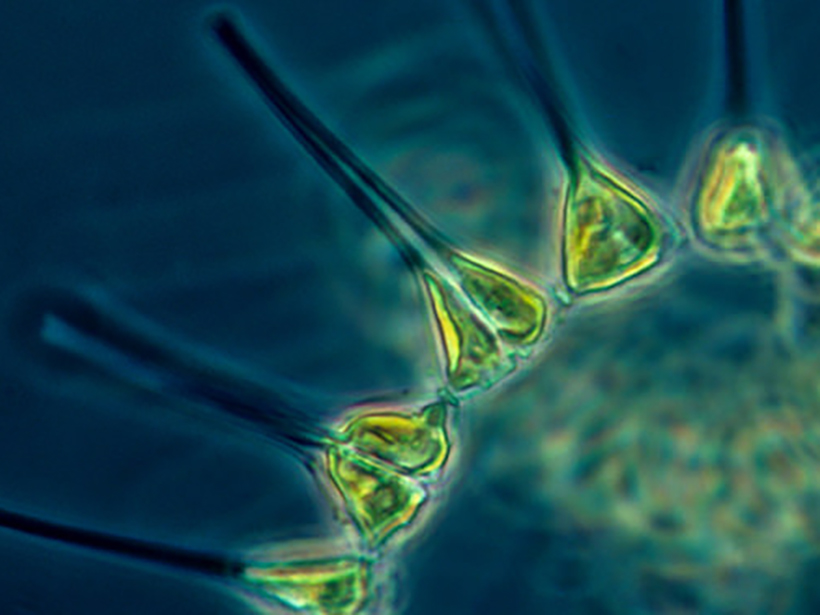Source: Journal of Geophysical Research: Oceans
Plankton are not just one species of sea creature but, rather, a large variety of tiny organisms. Algae, bacteria, crustaceans, mollusks, and more are all considered plankton. What sets them apart from other organisms is how they move. Their extremely small size precludes them from swimming against ocean currents, so they drift.
Plankton may be small, but these tiny drifters play a huge role in aquatic ecosystems. Many animals, including whales, rely on them for food. Plankton that are plants, known as phytoplankton, grow and get their own energy through photosynthesis and are responsible for producing an estimated 80% of the world’s oxygen. As such, climate scientists are interested in learning more about phytoplankton because of the role they play in oxygen production, as well as in carbon sequestration.
A recent study conducted by Bosse et al. demonstrated how powerful winter storms create oceanic structures that can affect the distribution of nutrients to phytoplankton communities, as well as the organisms’ ability to produce and store carbon. These oceanic structures, called submesoscale coherent vortices, or SCV, are isolated, long-lasting types of eddies (swirling seawater) that typically flow in the opposite direction of Earth’s rotation.
In June 2013, the researchers examined an SCV in the Ligurian Sea, a basin of the Mediterranean touching both Italy and France, that was formed several months earlier by a major winter mixing event caused by severe storms. They used an autonomous glider—a drone—equipped with sensors to detect oxygen and fluorescence: a stealthy property of many underwater creatures that allows them to absorb light at one wavelength, or color, and reemit it at another wavelength to avoid detection.
They then supplemented the glider’s measurements with data from an instrument, lowered from a ship, called a CTD, named after the properties its sensors detect: conductivity, temperature, and depth. They also collected water samples from within and outside the SCV, measuring levels of nutrients and phytoplankton pigments.
The team found that the core of the SCV (which traps and transports nutrients, plankton, and other living things) stretched vertically about half a kilometer to over a kilometer across below the sea surface. Consisting of highly uniform, oxygenated water, the core would have formed during the winter that preceded its summertime observation. The overall radius of the SCV, they found, was nearly 6 and half kilometers wide.
A kilometers-wide, swirling body of seawater might sound intimidating, but the SCV’s radius was actually unusually small, considering it had a relatively high Rossby number (the measurement of a fluid’s flow intensity). The researchers think that rotation sets up dynamical barriers, which control the transport and mixing of water properties within eddies. These barriers hampered the ability of water to spread out from the SCV’s core to the surrounding ocean.
Although the core of the SCV was fairly depleted of nutrients, such as nitrate, phosphate, and silicate (13%–18% lower than the nutrient-rich surrounding waters), there were more than enough to keep phytoplankton well fed, especially toward the sea surface. The team’s measurements show that phytoplankton, and even the tiniest nanoplankton, not only were plentiful inside the SCV but also were producing more carbon than ever.
By diving into the dynamics of this SCV, the researchers were able to show how these meteorological phenomena provide a place for phytoplankton to thrive. Such information helps scientists better understand the tiny critters that play a critical role in Earth’s changing climate. (Journal of Geophysical Research: Oceans, https://doi.org/10.1002/2016JC012634, 2017)
—Sarah Witman, Science Writer
Citation:
Witman, S. (2017), World’s biggest oxygen producers living in swirling ocean waters, Eos, 98, https://doi.org/10.1029/2017EO081067. Published on 13 September 2017.
Text © 2017. The authors. CC BY-NC-ND 3.0
Except where otherwise noted, images are subject to copyright. Any reuse without express permission from the copyright owner is prohibited.

